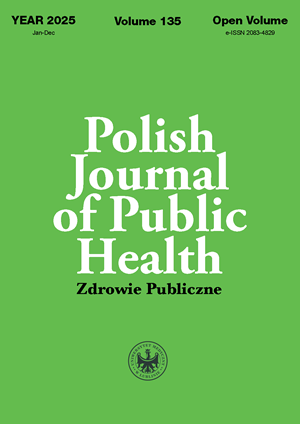The comparison of the dental needs of patients from Poland and Ukraineaged 21-30 years old based on panoramic radiographs
DOI:
https://doi.org/10.12923/2083-4829/2025-0001Keywords:
dental caries, dentistry in Ukraine, oral health, dental public health, educational status, dental hygieneAbstract
Introduction. Oral diseases are a serious problem of today’s population. Amongst the leading causes of oral health diseases, untreated dental caries, edentulism and severe periodontal disease are identified. The condition of the oral cavity in patients aged 21-30 years varies depending on multiple factors, such as diet, lifestyle, hygiene of the oral cavity, availability of dental care and many others.
Aim. The aim of this study was to compare the dental treatment needs of young adults from Poland and Ukraine based on panoramic X-rays.
Materials and methods. The material was derived from the database of panoramic radiographs taken in the years 2017-2022 at the Department of Dental and Maxillofacial Radiodiagnostics.
Results. Mean number of teeth in patients from Ukraine and Poland was comparable. The mean number of teeth with fillings was higher in Polish patients.
The number of carious cavities in patients from Ukraine and Poland was similar. Both periapical lesions and teeth qualified for extraction were more frequently observed in Ukrainian patients.
The average number of impacted third molars per person was higher in Polish patients. The study took into account gender differences.
Discussion. The authors studied the intensity of caries in different age groups, the condition of periodontal tissues, and the incidence of retained third molars. Epidemiological studies were conducted to assess the oral health of patients of different nationalities and to analyze their attitudes toward oral health through a questionnaire.
Conclusions. The dental status of the studied Ukrainian and Polish patients shows no significant differences, unsatisfactory level of treatment and comparable dental needs.
References
1. Fiorillo L. Oral Health: The first step to well-being. Medicina (Kaunas). 2019;55(10):676. https://doi.org/10.3390/medicina55100676
2. Jain N, Dutt U, Radenkov I, et al. WHO’s global oral health status report 2022: Actions, discussion and implementation. Oral Dis. 2023;10.1111. https://doi.org/10.1111/odi.14516
3. Sheshukova OV, Trufanova VP, Polishchuk TV, et al. Monitoring of efficiency of dental caries management in children’s temporary teeth throughout Poltava oblast. Wiad Lek. 2018;71(3 pt 2):761-7.
4. Bachanek T, Hendzel B, Wolańska E, et al. Condition of mineralized tooth tissue in a population of 15-year-old adolescents living in a region of Ukraine with slightly exceeded fluorine concentration in the water. Ann Agric Environ Med. 2019;26(4):623-9. https://doi.org/10.26444/aaem/110013
5. Wolgin M, Filina N, Shakavets N, et al. A systematic review of the caries prevalence among children living in Chernobyl fallout countries. Sci Rep. 2020;10(1):10323. https://doi.org/10.1038/s41598-019-39755-5
6. Olczak-Kowalczyk D. Choroba próchnicowa i stan tkanek przyzębia populacji polskiej. Podsumowanie wyników badań z lat 2016-2019. Ministerstwo Zdrowia; 2021. p.11-37; 299-326.
7. Shishniashvili T, Ordenidze T, Kipiani N, et al. Epidemiological characterization and pathogenetic peculiarities of dental caries in adolescents. Georgian Med News. 2019;(291):50-3.
8. Chaffee BW, Rodrigues PH, Kramer PF, et al. Oral health-related quality-of-life scores differ by socioeconomic status and caries experience. Community Dent Oral Epidemiol. 2017;45(3):216-24. https://doi.org/10.1111/cdoe.12279
9. Poudel P, Griffiths R, Wong VW, et al. Knowledge and practices of diabetes care providers in oral health care and their potential role in oral health promotion: A scoping review. Diabetes Res Clin Pract. 2017;130:266-77. https://doi.org/10.1016/j.diabres.2017.06.004
10. Menegaz AM, Silva AER, Cascaes AM. Educational interventions in health services and oral health: systematic review. Rev Saude Publica. 2018;52:52.
11. [https://cdn.who.int/media/docs/default-source/country-profiles/oral-health/oral-health-ukr-2022-country-profile.pdf?sfvrsn=275bef62_5&do wnload=true] (access: 20.10.2023)
12. Pawłowicz A, Bachanek T, Klijer M, et al. Periodontal condition in patients of the specialist Outpatient Clinics at the Institute of Rural Health in Lublin, Poland. Ann Agric Environ Med. 2018;25(1):9-12. https://doi.org/10.5604/12321966.1227649
13. Górski B, Poszytek D, Wojtasiak S, et al. Radiographic pathologies associated with third molar teeth in Polish population: A retrospective study. Post Hig Med Doświad. 2021;75:175-82. https://doi.org/10.5604/01.3001.0014.7867
14. [https://apps.who.int/iris/rest/bitstreams/1431126/retrieve] (access: 20.10.2023)
15. https://www.sunstargum.com/content/dam/sunstar-europe/gum/documents/press-releases/Press-release-SUNSTAR-Global-Healthy-Thinking-Report-2021.pdf (access: 20.10.2023)
Downloads
Published
Issue
Section
License
Copyright (c) 2025 Authors

This work is licensed under a Creative Commons Attribution-NonCommercial-NoDerivatives 3.0 Unported License.


